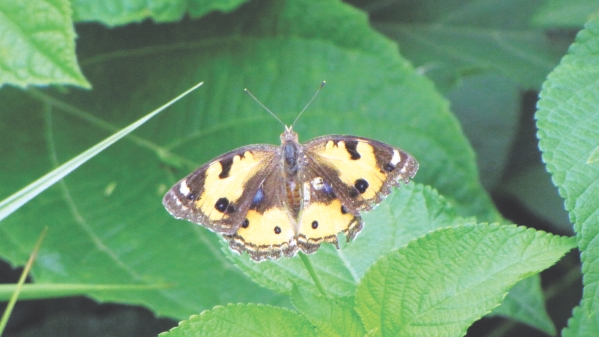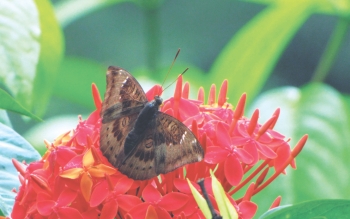| Home - Back Issues - The Team - Contact Us |
 |
| Volume 11 |Issue 21| May 25, 2012 | |
|
|
Wildlife
The Little Royals Dr Monwar Hossain Tuhin
Butterflies are the most majestic insects in the world. Their striking colours and patterns are fascinating. Adult butterflies feed on nectar and many others like swallowtails and pierids required minerals. Sometimes they take in fluids from ripe or rotting fruits, trees sap, mud, carrion and dung. Butterflies are very sensitive to climate change, which ultimately influences their distribution and abundance. This eventually leads to their migration. Classic example is the migration in monarch butterfly between North America and Mexico. Butterflies like 'tigers', 'crows', 'painted lady' and 'oak leaf' usually migrate from one place to another during unfavourable conditions in India. The Jahangirnagar University (JU) campus is rich in plant diversity. This diverse ecological habitat includes woodlands, climbers, vines, grasses, shrubs and herbs, making it an ideal habitat for various kinds of wildlife and an incalculable number of insects including butterflies to live and reproduce. Earlier (1997), a survey on butterflies in JU by the author and his team reported a total of 51 species, where 21 were newly recorded in Bangladesh. The next survey by the same group in 2003 raised this new record from 21 to 57 species.
Recently (2010) four more new species were reported in JU. These are: Striped Pierrot (Tarucus nara) ; Monkey Puzzle (Rathindra amor); Blue Pansy (Junonia orithya), a medium-sized, brightly-coloured butterfly that belongs to the family Nymphalidae; and Painted Lady (Vanessa cardui) another medium-sized, richly coloured butterfly that belongs to the family Nymphalidae with a wing spa of 5 to 9 cm. Among the newly recorded species, Monkey Puzzle is the most abundant, followed by Striped Pierrot moderate abundant, Painted lady is rare and Blue Pansy was found only once on the campus. These species are also found in India, Thailand and Malaysia.
Three more new species were discovered in 2011 – two from Lawachharha National Park and the other at Chimbuk in Rangamati. The results indicated that the JU campus had the greatest diversity of butterfly species compared to other places in the country. But even this story may not have a happy ending. The ongoing massive habitat destruction due to population pressures, changes in land-uses and overall environment pollution from the use of pesticides and fertilisers are major threats to butterflies in the country, including JU campus. A small house on JU campus called “Butterfly Hut” managed to breed a large number of endangered butterflies (like plain tiger butterfly) and re-introduced (around 400 species) them into nature in 2011. Besides that, the “Butterfly Fair” was arranged in 2010 and 2011 on the campus to create awareness among people about this beautiful creature. Dr Monwar Hossain is an associate professor at Department of Zoology, Jahangirnagar University. Copyright
(R) thedailystar.net 2012 |



